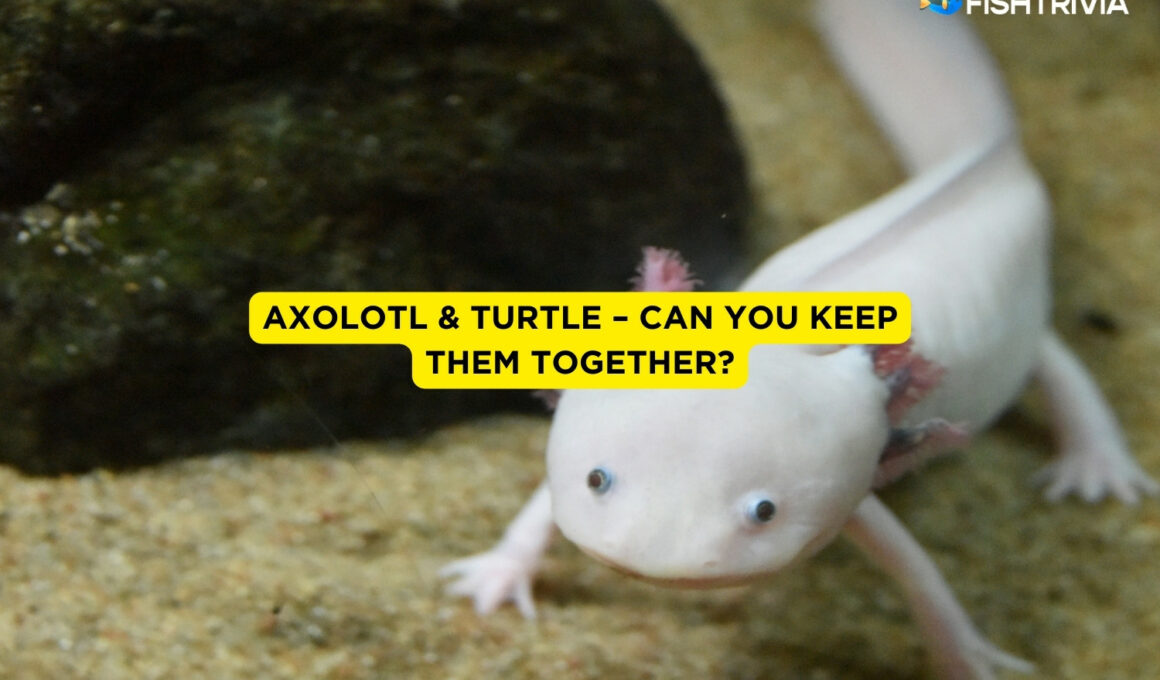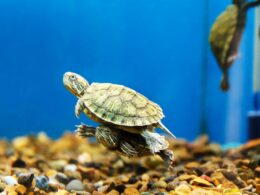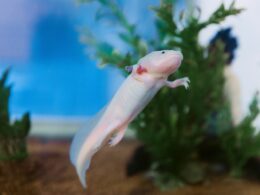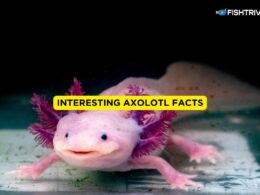In this article Show
Turtles and axolotls should be kept apart as they are somewhat different species. The first thing to remember with Axolotls and turtles is that their tank temperature needs differ. Turtles and axolotls have different optimal environmental temperatures.
While turtles prefer to live in an atmosphere of 68°F or under, axolotls demand basking regions of 90-100°F and water temperatures varying from 70 to 85°F.
In other words, maintaining Axolotls in an excellent habitat for turtles stresses them out. Conversely, keeping turtles in an area that is great for Axolotls will stress them. An Axolotl is also popularly known as a walking fish.
Most people refer to the Axolotl as fish, but they are, in a real sense, salamanders, though not the average salamanders. The difference between these kinds of salamanders and the normal ones is that the Axolotls do not have developed lungs.
Also worth reading;
- Can Turtles Live With Fish & What Fish Can They Live With?
- Tortoise vs. Aquatic Turtles – What’s The Difference?
Reasons Why Turtles And Axolotls Cannot Coexist Together
Axolotls are incredibly fragile though their skin is porous, Axolotls are delicate creatures.
Never handle them unless you must. In addition, this might be a threat to your axolotls, should the Turtle accidentally bump into them while Turtles are a sign of aggression.
A well-known fact about turtles is that they may instantly modify how they act and respond to a circumstance. Additionally, turtles produce large amounts of waste, impairing water quality. Ultimately, your pet Axolotl’s health will be affected.
Most animals other than turtles are good Axolotl mates; however, these claims aren’t valid. Some of these include:
- The axolotls are omnivores; thus, they will eat just about any fish with a body smaller than their mouth. This contrasts with the claim that more significant kinds of fish typically consume the gill of Axolotls. Furthermore, fish are often contaminated with parasites, and illnesses are passed to your Axolotls through the water.
- The fish known as the Plecostomus is sometimes referred to as an algae eater, algae sucker, algal sucker, or simply a Pleco. This fish possesses plates of bony material covering the majority of its head on top of sharp protective spikes.
- Many different kinds of salamanders have adapted to survive in habitats that do not meet Axolotl’s requirements. Furthermore, certain salamanders release toxic chemicals that can be detrimental to Axolotls.
- While Axolotls and newts can live together peacefully in nature, they could prove to be quite different in small constructed environments. Newts mistake the Axolotls’ exterior fins for food because they live together in small groups.
Though an aquarium’s wide area and significant water volume may not be sufficient to replicate the natural environment, an aquarium will nonetheless show you where a natural habitat would be in that particular location.
- Consider that of the 70 to 80 percent of toads or frogs that can live in warm-to-hot tropical climates, most of them are toads and frogs. Toads and frogs can also spread sickness and parasites to your Axolotls, much like many other fish species.
- Lizards: The ability to retain body heat is not a trait of lizards, which necessitates a thermal environment that would be too high for Axolotls.
Cory catfishes, goldfish, and Otocinclus catfish should also be avoided as companions for Axolotls. Many Axolotl aficionados feel that isolated Axolotls are necessary in-home aquariums. They feel that this will prolong their life span and help them stay healthy.
The Best Tank Mates For Axolotls
These are the best tank buddies you can get for axolotls;
1. The Small Shrimp
Amano shrimp, glass shrimp, and ghost shrimp are types of tiny shrimp that eat on the bottom.
They work well in the Axolotl tank since they are bottom feeders. Because they feed on leftover food at the bottom of the tank, they function as natural aquarium cleaners.
They are little, so they make good treats for pets who are hungry. Axolotls have no trouble choking on shrimp. You should keep the two kinds of Axolotl apart for around 30 days to reduce the transmission of illnesses.
2. The Aquarium Snail
However, it would be best if you did not house smaller water snails with Axolotls, such as Ramshorn snails, apple snails, or bladder snails due to size differences.
This is another term for the class of snails known as species with a softer skeleton.
Many aquarists have observed that Axolotls and young snails do not interfere with one another. Despite these reasons, be careful with snails, because you should do so because of the following:
- If broken snail shells puncture your Axolotl’s stomach lining, then Axolotls, like snails, have an acidic stomach.
- It will be hard to remove these occupants once they settle in your tank.
3. Guppies
The fish guppies may coexist peacefully with Axolotls. Axolotl pets have no trouble swallowing tiny objects because they don’t have hard exoskeletons.
On the other hand, guppies have several shortcomings:
- They are an unending proliferation of individuals, meaning their numbers rapidly rise. Even if you put a big group of guppies in a tank with Axolotls, your Axolotls will still be stressed.
- Because axolotls have such fin-like appendages, guppies are nimble. Almost all guppies in pet stores are infected with parasites and illnesses.
To put it another way, if you want to keep your guppies in the same tank as your Axolotls, you should always get your guppies from reliable vendors.
4. Minnows
It is well worth the effort to house an Axolotl with a white cloud mountain minnow, which some consider the ideal species of fish to maintain with Axolotls.
Tiny-sized fishes seek circumstances that are comparable to Axolotl habitats. They are almost entirely harmless and do not have a hard shell or spine.
Even if you are sure your Axolotls would not eat them, you should still keep watch while placing them in the same tank as Axolotls since they may quickly become appetizers. As a result, Axolotls make good tank mates by themselves.
The theory goes that it is safest to have your Axolotl, Axolotl A, stay with her Axolotl, Axolotl B. Additionally, you can match a man with just a female to increase the chances of having children.
It is also essential to remember that the larger Axolotls in the aquarium will often eat the smaller ones. It frequently happens, especially to young axolotls; therefore, the behavior is referred to as “alpha male syndrome” or “bullying.”
If you are planning to put two Axolotls together, make sure to get adult Axolotls exclusively. If possible, obtain Axolotls of the same age.
Best Tank Mates For Turtles
Many consider other species to keep as tank mates because they believe they have comparable habitats within the wild or believe the creatures will look well together.
Though you may take appearances into consideration when considering tank mates, you must also be aware of the tank mates’ requirements areas if they might pose a threat to your Turtle or vice versa.
While many Amphibians pose a minor threat to inexperienced herpetoculturists, these Amphibians can emit poisonous compounds from their skin and have more fragile bodies, which turtles can injure. When it comes to turtles, their high waste production rate and possible health risks make them an unfavorable choice.
Even while animals can coexist in the surroundings of their natural habitat, it doesn’t imply it is a good idea to place them together and in captivity.
Species That Cannot Be Tank Mates With Turtles
The following are species that cannot coexist in a tank with turtles;
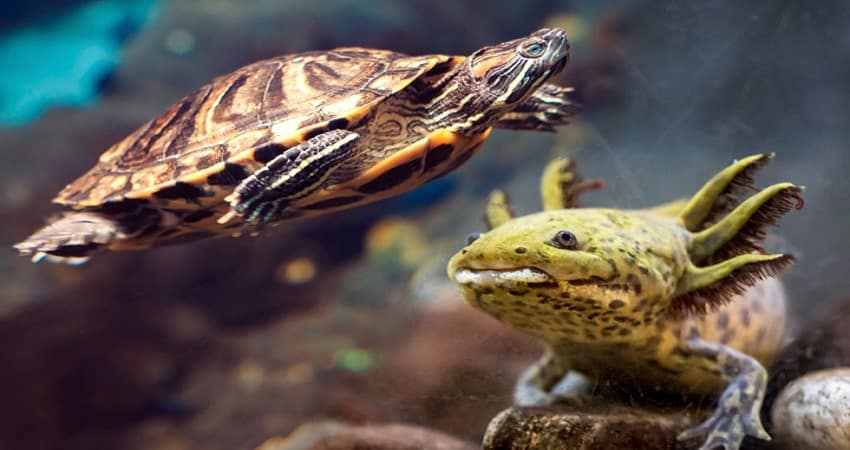
1. Crustaceans
One kind of crab, the shrimp, is suitable for your tank because it eats algae and food leftovers that collect at the bottom of the tank.
Even though many turtles consume shrimp, crabs, and crayfish, you should be careful to keep any of them in the tank as some turtles could view them as food.
2. Snails
It might become your Turtle’s supper if the snail is large. It’s a bet whether or not it will be noticed.
3. Fish
Turtles are omnivores, most of them. As a result, these creatures are only able to consume fish as a natural meal. Fish, therefore, will be their initial food source. Where fish are often found, their greater opportunity to hide and evade predators helps them survive.
While the danger of getting busted and wounded or eaten is greater in a fish tank, the possibility of getting busted and detained is higher in a fishbowl.
Conclusion
Many questions if the tank of a turtle can be topped out with other living animals. One could examine all possible options, but the Turtle has a good chance of eating the food placed in their aquarium.
While you are getting your new fish or equipment ready, your Turtle may feel safer and more comfortable if you first feed it. Hungry turtles will be more prone to become aggressive toward any new additions to the tank.
Unlike certain amphibians, axolotls do not pass through metamorphosis, including the development of gills and change into adulthood. Softshell turtles are unsuitable tank mates for any Turtle.
Fast-moving fishes may coexist with newborn softshell turtles, according to some pet owners. If two turtles of the same species reside in the same tank, a softshell turtle will feel more at ease.






